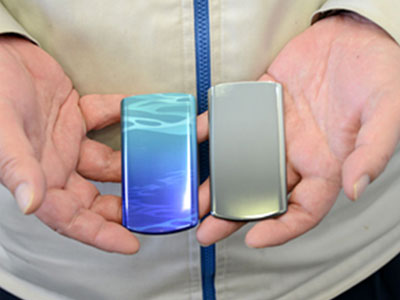In-mold Decoration technology – a process that combines injection molding with the application of decorations in one single step – was being used in the manufacture of a wide range of products. Aluminum vacuum metallization cannot be used in devices that emit electromagnetic waves, however, because it may interfere with transmission. For this reason, YOSHIDA TECHNOWORKS newly developed In-mold Decoration technology for non-conductive vacuum metallization to solve this challenging issue.
A new challenge posed by high-performance mobile phones
With In-mold Decoration technology, plastic parts are not only shaped, but are simultaneously decorated without the need for manual post-molding operations, enabling the application of luxurious designs and a metallic finish to many different products. In products such as cosmetic compact cases, the aluminum vacuum metallization process is applied directly to plastic materials to provide a metallic sheen, as the use of real metals increases both the cost and weight of such products. As perhaps expected, we received many requests from customers looking to add these same exquisite design elements to their mobile phones.
There was one problem, however. There was not an issue as long as mobile phones had a single antenna, but with advent of multi-antenna mobile phones we discovered that conventional aluminum vacuum metallization gave rise to interference in cellular reception and transmission.
Developing new technology to overcome the interference problem
Other than aluminum, which metals would not result in interference? We found two: tin and indium.
Since both tin and indium are deposited discontinuously, the outside surface of the mobile phone is not covered completely during vacuum metallization, thereby allowing for cellular reception and transmission. The simplest method of depositing these metals is to use a VM chamber, as with aluminum. This method drives up cost, however, due to lower yield.
To solve this, Mr. Arakawa proposed a non-conductive vacuum metallized In-mold Decoration using a scratch-resistant hard coat transfer foil. He argued that, by applying our aluminum VM In-mold Decoration technology, it should be possible to reproduce the desired effects with other metals.
Different metals behave differently, however. While we had succeeded in meeting the functional requirements, creating the beautiful metallic finish proved challenging.
The development process was long and full of trial, but eventually we succeeded in achieving both design and functionality – metallic finish that did not cause interference.
NCVM In-mold Decoration is the answer for a range of designs
One of the advantages of NCVM In-mold Decoration is the range of designs possible by combining tin VM foil with a graphic foil on the front and rear surfaces of a transparent panel. Mr. Arakawa says that one of the pleasures of being an engineer is the ability to create astonishing, beautiful designs from a single idea.
Despite its outstanding designability, there are still problems with NCVM In-mold Decoration, however. This process has short lead times and is inexpensive, making it well suited to higher volume production, but products lack the glossy sheen of metals processed in a VM chamber.
In-mold Decoration technology is the combination of in-mold foils and molding technology.
“I hope to continue pursuing the ultimate metallic finish in collaboration with the print makers who manufacture the foil,” concluded Mr. Arakawa.


